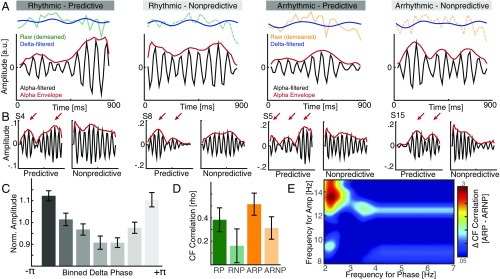Fig. 2.
Comodulation of perceptual cycles during top-down processing. (A, Upper) Demeaned raw hit rates time courses superimposed with the low-pass filtered time course (blue). (Lower) Alpha filtered time course (black) and the corresponding envelope (red). Note that the alpha envelope is not constant over time but exhibits rhythmic modulations. We hypothesized that there might be a relationship between the slow and the faster component. (B) Inspection of single subject time courses for predictive and nonpredictive contexts indicated that this modulation might be pronounced for predicted contexts. (Left) Two examples from rhythmic stimulus presentations; (Right) two arrhythmic examples. (C) Grand average histogram of the nonuniform distribution of the normalized alpha amplitude relative to the delta phase. (D) Cross-frequency correlation analyses revealed a main effect for predicted contexts. However, the group results indicate that the strongest correlation was observed for arrhythmic sensory stimulation with predictive context. The lowest correlation was observed when no predictive cues were present and the sensory input was presented at 10 Hz. (E) Difference comodulogram for the arrhythmic condition (predictive−nonpredictive) indicates that the effect was most prominent between the 2- to 3-Hz phase and the high alpha amplitude.

